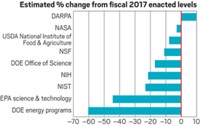Advertisement
Grab your lab coat. Let's get started
Welcome!
Welcome!
Create an account below to get 6 C&EN articles per month, receive newsletters and more - all free.
It seems this is your first time logging in online. Please enter the following information to continue.
As an ACS member you automatically get access to this site. All we need is few more details to create your reading experience.
Not you? Sign in with a different account.
Not you? Sign in with a different account.
ERROR 1
ERROR 1
ERROR 2
ERROR 2
ERROR 2
ERROR 2
ERROR 2
Password and Confirm password must match.
If you have an ACS member number, please enter it here so we can link this account to your membership. (optional)
ERROR 2
ACS values your privacy. By submitting your information, you are gaining access to C&EN and subscribing to our weekly newsletter. We use the information you provide to make your reading experience better, and we will never sell your data to third party members.
Environment
Shifting R&D Budget Priorities
by Rudy Baum, Editor-in-chief
February 20, 2006
| A version of this story appeared in
Volume 84, Issue 8
As is almost always the case with the federal R&D budget, the 2007 version contains both good news and bad news. The good news is that, after years of benign neglect, the physical sciences are receiving a significant boost in funding. The bad news is that, overall, the R&D budget is essentially flat from 2006. That is not the trend line the U.S. should be following.
C&EN's comprehensive coverage of the R&D budget proposed by the Bush Administration for fiscal 2007 begins on page 27. Most of C&EN's Government & Policy Department staff dove into the massive federal budget to extract the information contained in the report: Assistant Managing Editor David J. Hanson, Senior Correspondent Lois R. Ember, Senior Editors Bette Hileman and Jeff Johnson, Associate Editor Susan Morrissey, and Contributing Editor Glenn Hess.
The story notes that recent federal R&D budgets have focused their largesse primarily on defense and homeland security spending and biomedical R&D. By contrast, in the 2007 budget, President Bush "has proposed increases in physical science funding at several agencies, notably the National Science Foundation, National Institute for Standards & Technology, and Department of Energy," the C&EN report states. "These increases, however, are offset by reductions in science and technology spending at the Departments of Defense, Agriculture, and Commerce, and by proposing no increase at the National Institutes of Health."
A particular bright spot is the NSF budget. As a result of President Bush's American Competitiveness Initiative, NSF's budget will grow to $6 billion in 2007, up nearly 8% from 2006. The increase puts NSF on a path to double its budget in 10 years, a goal actively promoted by the American Chemical Society and several other associations focused on the physical sciences.
NSF's grant program is slated to receive $4.7 billion, up 7.7% from 2006. This increase would allow the number of competitive grants to grow by about 550 to a total of 10,310 in 2007. The Mathematical & Physical Sciences Directorate, where chemistry lives at NSF, would see growth of 6% to bring the 2007 budget to $1.2 billion. Chemistry, which has the smallest overall budget of the MPS science divisions, is slated to be funded at $191 million.
DOE receives a similar boost. As the C&EN report notes, "Funding increases proposed for the Department of Energy could be a bonanza for scientists." Under the President's budget, DOE's Office of Science, for example, would receive an increase of $506 million, or 14%, over 2006, taking the science office's funding to $4.1 billion. The Administration's plan is to increase funding to $7.2 billion in 10 years.
The budget would increase research in solar energy and biofuels by about $60 million each, bringing each to about $150 million, 70% more than current funding. Nuclear spending would increase by 18% to $632 million, more than half for R&D, which increased by 50%. These are incredibly important investments in our nation's future, as we begin to learn to wean ourselves from our dependence on fossil fuels.
Things aren't as bright at NIH, which only a few years ago saw substantial year-to-year growth in its funding as Congress was consciously doubling the agency's budget. The 2007 budget request for NIH holds the agency's funding flat at $28.5 billion. I find it somewhat startling that $1.89 billion, or 43%, of the National Institute of Allergy & Infectious Diseases' $4.4 billion total budget is directed to homeland-security-related biodefense research programs. I know the U.S. is obsessed with terrorism, but this seems to skew NIAID's research priorities in an entirely unjustified way.
A number of annual charades are reenacted in the 2007 budget. Once again, President Bush has zeroed out NIST's Advanced Technology Program, which must be on its fifth or sixth life. Congress annually rescues ATP, and very likely will again this year. The Administration claims that much of the budget trimming at agencies like USDA comes from eliminating about $2.4 billion worth of R&D earmarks added to last year's budget by members of Congress. Given that earmarks have swelled by something like a factor of 10 over the past decade, it's not likely that President Bush will be any more successful this year than he has been in the past in reining in this practice.
Thanks for reading.




Join the conversation
Contact the reporter
Submit a Letter to the Editor for publication
Engage with us on Twitter